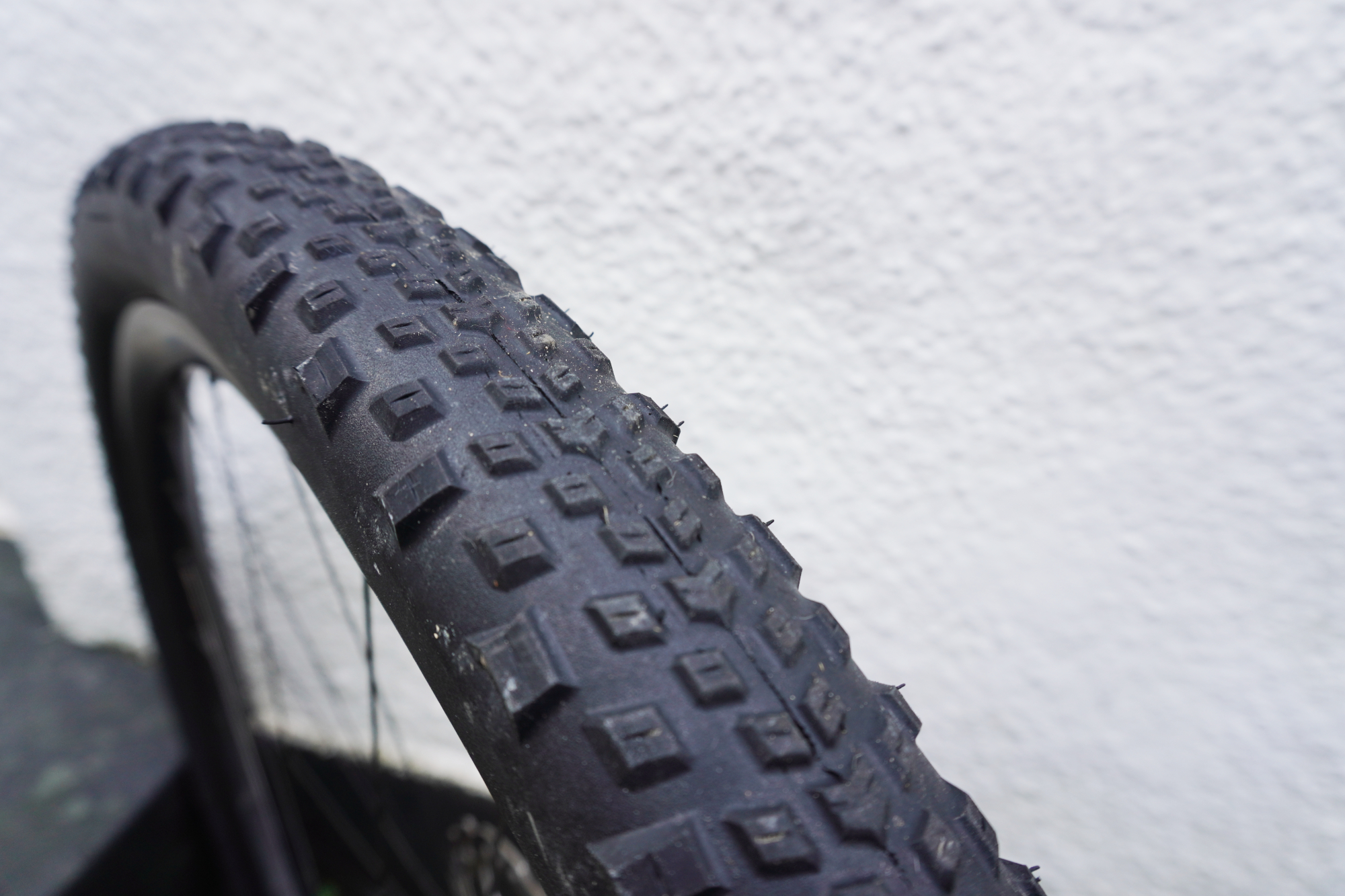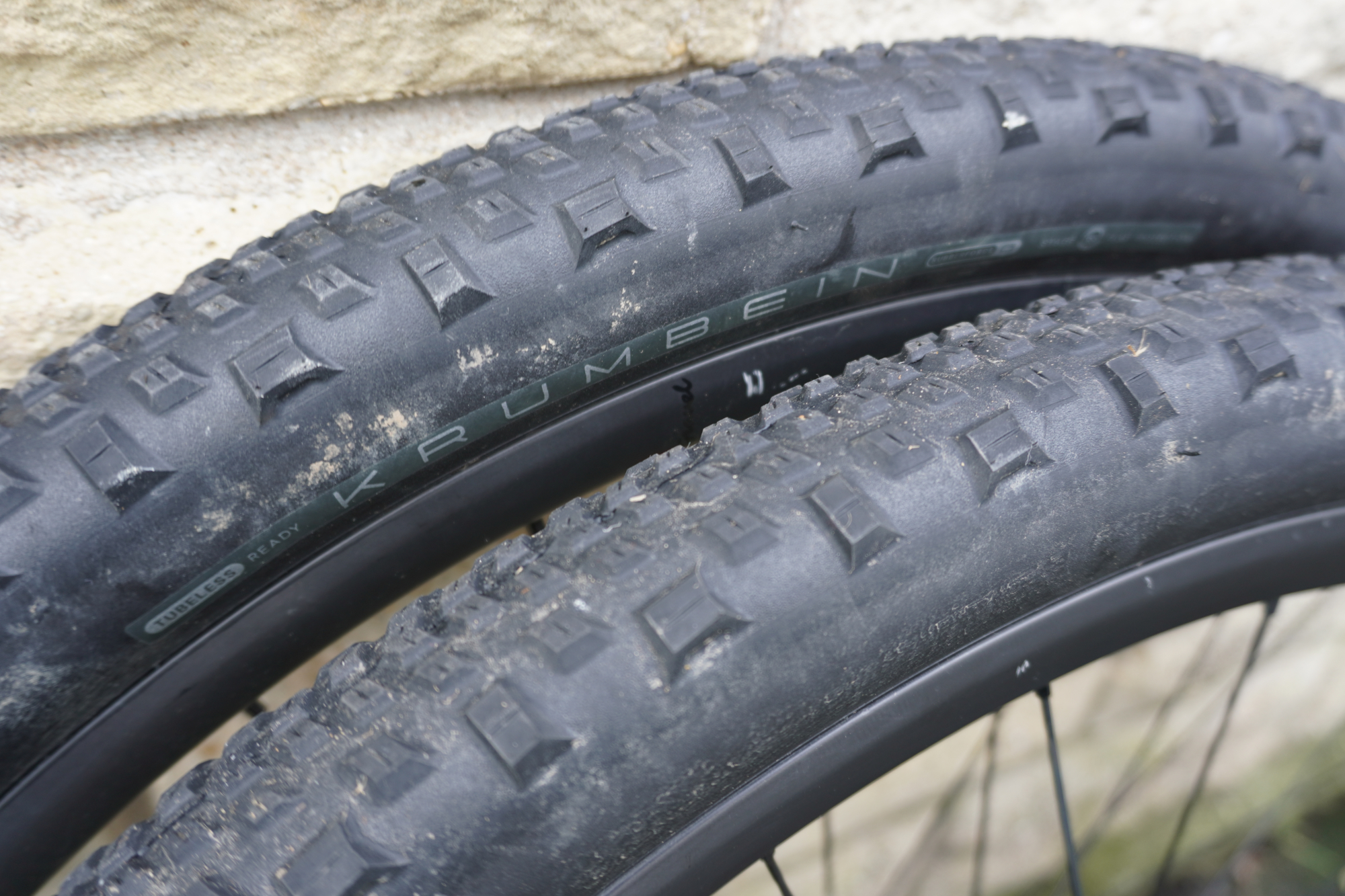American Classic Krumbein gravel tyre review
Impressive performance for such a cheap tyre

At just over half the price of many performance gravel tyres, American Classic’s Krumbeins are notably cheap. The puncture protection and grip (in dry conditions) is particularly impressive, but naturally there are some areas which see a compromise. The compound isn’t very tacky, compromising grip on wet rocks, and they do weigh quite a bit. If you’re after a performance tyre, you’re going to need to increase your price band a fair bit, but if you’re just after something which is robust and does an all-round reasonably good job, these are a very economical option.
-
+
Robust, durable carcass
-
+
Grippy in dusty conditions
-
+
Higher volume sizes
-
+
Very cheap
-
-
The compound isn’t very tacky and struggles on wet rocks
-
-
The knobs are still too shallow to be good in the mud
You can trust Cycling Weekly.

American Classic launched in 1982, manufacturing wheels, hubs and seat posts. Although it closed down in 2018, the brand relaunched in 2021 with a whole new range of tyres.
Across the models, the design is geared towards maximum performance at minimum cost – they’re not trying to compete directly with the very best tyres on the market, instead going for functional affordability.
For a complete overview of all the tyres in the range (there are a lot!), you can check out our launch story over here. Otherwise, let’s dig into the Krumbeins
The construction: American Classic Krumbein
The Krumbeins feature the Rubberforce G compound which was designed specifically for American Classic’s gravel range. It's said to provide “excellent abrasion resistance, high tensile strength, and good tear and cut resistance for off-road riding and exploring.”
It’s paired with “Stage 5S Flat Protection”, providing bead-to-bead puncture and tear protection, courtesy of a “microfibre composite tread compound and undertread protective layer.”
The tread itself consists of smaller blocky knobs down the centre of the tyre, to minimise the penalty on rolling speed, with a transition out to larger and taller knobs on the shoulders, for added grip when banked over in the corners.

Naturally, for a gravel tyre, it’s tubeless ready and compatible with hookless (straight sided rims). There is a ‘tan’ sidewall option, but this is purely aesthetic – rather than the carcass actually being left bare to increase the suppleness. There are only available in three sizes, 40mm x 700c, 50mm x 700c, and 47mm x 650b.
The latest race content, interviews, features, reviews and expert buying guides, direct to your inbox!
Unusually for a tyre brand – it's more common for wheels – if you manage to damage the Krumbeins to the point that they can no longer hold air, American Classic will give you 50% off the MSRP of a new one to get you rolling again.
The ride
Popping the tyres on my scales before setting them up, their heft was quickly confirmed. The 50mm x 700c version came in at 752 grams, which is 17 grams over the claimed weight and notably heavy for a gravel tyre.
For context, Schwalbe’s G-One Ultrabite tyres – similarly burly and arguably more aggressively treaded – have a claimed weight of 665 grams in 50mm x 700c. The comparison with MTB tyres is even less favourable, Schwalbe’s Rocket Ron XC tyres have a claimed weight of 595 grams in 54mm x 700c.
Then again, the Krumbeins are significantly cheaper than either of those tyres. When you’re balancing weight, protection and price, one of those is always going to be sacrificed.

Even two-inch tyres won't be getting over that...
Getting them inflated on a set of wheels went largely without issue. They were a little stiffer than some to get mounted on the rim and required a few more blasts with an air-chamber track pump to seal the bead against the rim.
That said, it still wasn't a struggle, with the experience about par for the course when it comes to gravel tyres.
The Krumbeins have definite strengths and weaknesses. Even top end tyres don’t tend to be flawless – going cheaper only increases the scope for compromises. At this price point, it will always be a balance of which areas of performance are you willing to give up.

Of the good points, the puncture protection performed well when set up with sealant, never losing a significant amount of pressure when out on a ride. Equally the sidewalls stood up well against unkind, rocky descents.
I've used these tyres with Tubolito’s City/Tour inner tubes and did get a flat – which reflects pretty unfavourably on both. The tubes are supposed to be unpuncturable, but if the tyre's puncture protection was perfect, then it wouldn’t have happened anyway. All that said, when set up with even basic sealant, I never had a problem.
Writing this review in February, thoughts of dry and dusty trails feel quite a distant notion. However when riding in the tail-end of the summer, I found the size and shapes of the knobs provided a respectable amount of grip over small, shingle-y rocks and finer dust. Of course they don’t work miracles – deep patches are always unpredictable, providing ample grip right up until they don’t – but generally they were good.
On tarmac sections on the way to the trails, the rolling resistance doesn’t feel a massive drag. I’d be frustrated if I was racing – performance mountain bike tyres turn over faster than the Krumbeins – but for general riding they passed the bar. Although maximum speed isn't always a priority, it’s never fun feeling like you’re riding through treacle.
Now, to the downsides. My main complaint is regarding the tackiness of the compound. Or lack of it. On wet rocks, it’s not the tread that provides the grip, but the rubber itself. Other gravel tyres, such as the Schwalbe Ultrabites, have a pretty tacky compound that grips well in wet, rocky conditions. The Krumbeins, on the other hand, felt rather skittish and slippery, limiting how fast I could take the corners.
The other point is more an observation than a criticism. Although the tread is more aggressive than many gravel tyres out there, the knobs still aren’t tall or widely spaced enough to work well in the mud. They neither dig in deeply enough or shed the clag quickly enough. In short, if you’re after a gravel tyre that can handle the winter slop, the Krumbein isn't it.
Value
At $35.00 dollars per tyre, American Classic’s Krumbeins are notably cheap. Although Schwalbe’s aggressive G-One Ultrabite gravel tyre really impressed us – being light and having better grip on wet surfaces – it comes in at $62.00 a tyre. The Teravail Rutland, in its 47mm x 700c width and with its ‘durable’ casing, comes in at $65 per tyre.
Verdict
American Classic’s Krumbein tyres are a particularly cheap option for a high volume and more aggressive gravel tyre. They do have their drawbacks, being rather heavy and using a compound that isn’t super tacky in the wet. But they are also impressively robust, grippy in the dry and have a reasonable rolling speed.
If you baulk at the thought of paying over $60 for a bike tyre, you’re unlikely to be disappointed – just don’t expect them to be quite as fast, light or grippy as rubber almost twice the price.
Specs
- Weight: 752g
- Sizes: 40mm x 700c, 50mm x 700c, 47mm x 650b
- Sidewalls; Black, Tan
- Contact: www.amclassic.com
FAQs
What is the tyre size of a gravel bike?
Typically, gravel bikes will use tyres between 35–54mm / 1.4–2.1in – but there is no hard and fast rule. It’s perfectly possible to ride smoother off-road trails on tyres as narrow as 28mm, whilst there are some gravel bikes that go much wider, such as the Mason InSearchOf which can fit up to 71mm / 2.8in tyres.
There are also two wheel diameter sizes that are typically used on gravel bikes. The larger tends to be referred to as 700c by road cyclists and as 29in by mountain bikers, but both refer to the same rim diameter. The smaller has a similar variety of names, referred to as 650b or 27.5in, depending on who’s talking – both are the same diameter though.
Can you put road tyres on a gravel bike?
You can – but do consider what tyres the bike was designed around. 50mm x 700c tyres have a lot larger a volume than a set of 28mm x 700c – swapping between those two reduces the effective wheel size and will have a negative impact on the handling.
That said, a 47mm x 650b tyre actually has a similar total diameter to a 28mm x 700c – the fat rubber and small wheel is almost identical to skinny rubber and large wheel. Putting road tyres on a gravel bike designed about this wheel size won’t cause any trouble at all.
Are 35mm tyres OK for gravel?
Depending on how smooth the gravel is, you could even ride off-road on 28mm tyres, but it would be less comfortable and you wouldn’t be able to ride rougher and rockier trails without risking damaging your rims.
To give a little context, on the Vies Verdes paths around Girona, we’d very happily ride 35mm gravel tyres. But on the rocky bridleways of the UK, you’ll be most comfortable riding tyres at least 50mm / 2in wide.
How do I choose a gravel bike tyre?
First think about how rough, pitted and bumpy the trails you want to ride are. If they’re pretty smooth and you want maximum speed, that would suggest a 40mm tyre might be best for you. If you’re not concerned about speed as much as comfort and are planning on riding some more extreme stuff, going as wide as your frame allows is your best bet.
Then, think about the surfaces, if it’s quite hard and smooth, you can get away with a less aggressive tread – when there’s nothing for the knobs to dig into, they don’t provide any better grip and just slow you down. On those surfaces, the grip comes from the compound of the rubber.
If it’s quite dusty, or there’s lots of loose, little rocks, or if there’s a sloppy layer of mud, taller and more widely spaced knobs will be a better choice for you.

After winning the 2019 National Single-Speed Cross-Country Mountain Biking Championships and claiming the plushie unicorn (true story), Stefan swapped the flat-bars for drop-bars and has never looked back.
Since then, he’s earnt his 2ⁿᵈ cat racing licence in his first season racing as a third, completed the South Downs Double in under 20 hours and Everested in under 12.
But his favourite rides are multiday bikepacking trips, with all the huge amount of cycling tech and long days spent exploring new roads and trails - as well as histories and cultures. Most recently, he’s spent two weeks riding from Budapest into the mountains of Slovakia.
Height: 177cm
Weight: 67–69kg